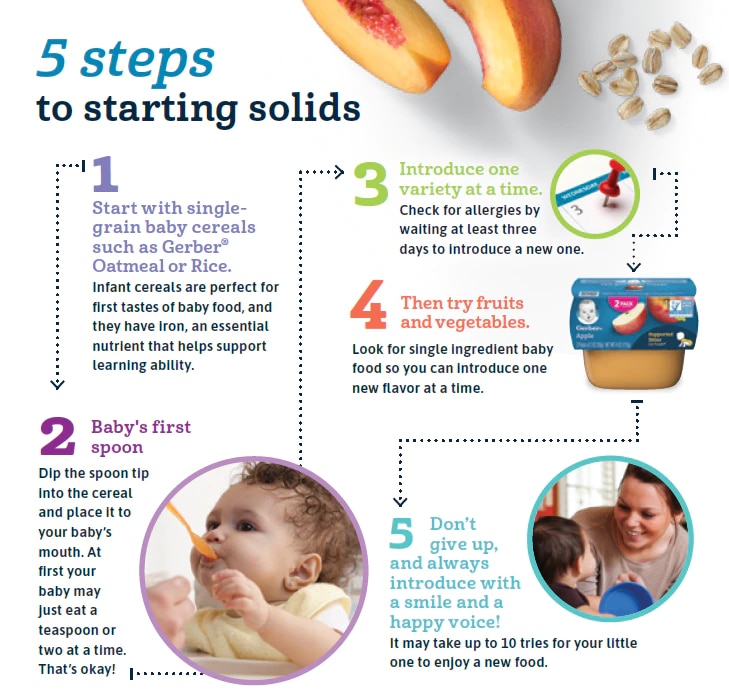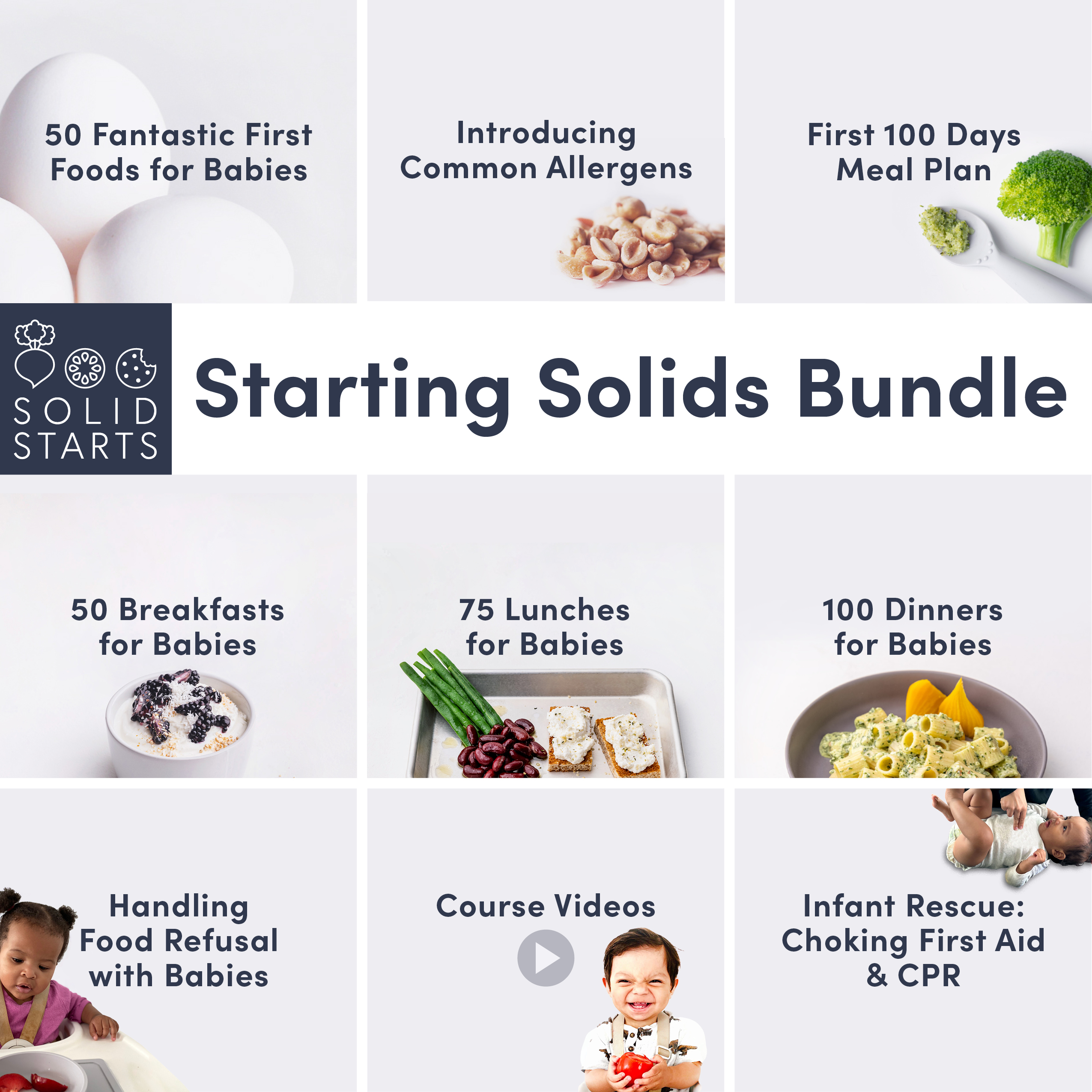Start introducing solids to your baby around six months old. Begin with single-ingredient purees like vegetables or fruits.
Introducing solids to your baby is an exciting milestone. Around six months, your baby is usually ready for more than just breast milk or formula. Start with single-ingredient purees, such as mashed carrots, sweet potatoes, or apples. Gradually introduce new foods, waiting three to five days between each to monitor for allergies.
Always ensure the food is smooth and easy to swallow. Use a small spoon and offer small amounts. Pay attention to your baby’s cues; they will show interest when they’re ready. Avoid salt, sugar, and honey in your baby’s diet. Remember, introducing solids is a gradual process, complementing milk feeds. Enjoy this new phase in your baby’s development!

Credit: www.gerber.com
When To Start Solids
Introducing solids to your baby is a significant milestone. Knowing when to start is crucial for your baby’s health and development. This section will guide you on when to begin and what signs to look for.
Signs Your Baby Is Ready
- Your baby can sit up with minimal support.
- They show interest in your food.
- Your baby has good head control.
- They have doubled their birth weight.
- Your baby opens their mouth when food is offered.
Optimal Age For Introducing Solids
The optimal age to start solids is around six months. At this age, most babies show readiness and need extra nutrients. The World Health Organization recommends this age to ensure proper growth and development.
Introducing solids before four months can lead to health issues. Waiting too long might cause nutritional deficiencies. Always consult with your pediatrician before starting.
| Age (Months) | Developmental Milestone |
|---|---|
| 0-4 | Exclusive breastfeeding or formula feeding |
| 4-6 | Signs of readiness appear |
| 6+ | Optimal time to introduce solids |
First Foods To Offer
Introducing solids to your baby is an exciting milestone. It’s essential to start with the right first foods. Choosing the best initial foods helps ensure your baby has a smooth transition.
Single-grain Cereals
Single-grain cereals are a great starting point. They are easy to digest and less likely to cause allergies. Rice cereal is a popular choice.
- Rice Cereal: Mix with breast milk or formula for a smooth texture.
- Oatmeal: Rich in fiber, it helps with digestion.
- Barley Cereal: Another good option, offering different nutrients.
Ensure the cereal is iron-fortified. Iron is vital for your baby’s development.
Fruits And Vegetables
Fruits and vegetables are nutritious and tasty. They provide essential vitamins and minerals.
- Bananas: Mash them for a smooth, sweet treat.
- Avocados: Rich in healthy fats, easy to mash.
- Sweet Potatoes: Boil, mash, and serve; they’re naturally sweet.
- Pumpkin: Cook and puree for a smooth texture.
Introduce one fruit or vegetable at a time. This helps identify any potential allergies.
| Food | Type | Preparation |
|---|---|---|
| Rice Cereal | Grain | Mix with milk |
| Banana | Fruit | Mash |
| Sweet Potato | Vegetable | Boil and mash |
| Avocado | Fruit | Mash |
Offer a variety of foods to ensure a balanced diet.
Creating A Feeding Schedule
Introducing solids to your baby is an exciting milestone. Creating a structured feeding schedule helps in this transition. A feeding schedule ensures your baby gets all necessary nutrients.
Timing And Frequency
Timing and frequency are crucial in a feeding schedule. Start with one meal per day. The best time is mid-morning or early afternoon. This gives your baby time to digest. Gradually increase to two meals per day. Each meal should be about 1-2 tablespoons. Observe how your baby reacts. Adjust the schedule based on their needs.
Balancing With Milk Feeds
Milk feeds are still essential. Breast milk or formula should remain the primary source of nutrition. Offer solids after milk feeds. This ensures the baby gets enough milk. Gradually, the balance will shift towards more solids. Here is a simple table to help balance milk feeds with solids:
| Age | Milk Feeds | Solids |
|---|---|---|
| 6-7 months | 4-5 times a day | 1 meal per day |
| 8-9 months | 3-4 times a day | 2 meals per day |
| 10-12 months | 2-3 times a day | 3 meals per day |
Observe your baby’s cues. They will guide you in adjusting the schedule. Always consult with your pediatrician.
Preparing Homemade Baby Food
Preparing homemade baby food can be a fun and rewarding experience. You control the ingredients and ensure your baby eats fresh and healthy meals. Let’s explore some simple recipes and storage tips to make this process easier.
Simple Recipes
Homemade baby food recipes can be simple and nutritious. Here are some easy recipes:
- Mashed Bananas: Peel a ripe banana and mash it until smooth.
- Sweet Potato Puree: Cook sweet potatoes, then blend until smooth.
- Apple Sauce: Peel and cook apples, then puree until smooth.
Storage Tips
Proper storage of homemade baby food keeps it fresh and safe. Follow these tips:
- Use airtight containers to store food.
- Label containers with the date and type of food.
- Store food in the fridge for up to 3 days.
- Freeze food in ice cube trays for longer storage.
- Thaw frozen food in the fridge before use.
| Food | Fridge Storage | Freezer Storage |
|---|---|---|
| Mashed Bananas | Up to 2 days | Not recommended |
| Sweet Potato Puree | Up to 3 days | Up to 3 months |
| Apple Sauce | Up to 3 days | Up to 6 months |
Safety Tips
Introducing solids to your baby is an exciting milestone. Ensuring your baby’s safety during this transition is crucial. Below are important safety tips to keep your baby safe and healthy.
Avoiding Choking Hazards
Babies are prone to choking on small foods. Here are some tips to avoid choking hazards:
- Cut food into small pieces. Small pieces are easier to swallow.
- Avoid round foods like grapes. Slice them into smaller pieces.
- Remove seeds and pits from fruits. These can be choking hazards.
- Offer soft foods. Cook vegetables until soft.
- Supervise your baby while eating. Never leave them unattended.
Allergy Awareness
Allergies can be a concern when introducing new foods. Follow these steps to minimize risks:
- Introduce one new food at a time. Wait three to five days before trying another.
- Watch for signs of allergies. Symptoms include rash, swelling, or difficulty breathing.
- Consult your pediatrician before introducing high-risk allergenic foods. These include peanuts, eggs, and shellfish.
- Keep an allergy action plan. Know what to do in case of a reaction.
- Have emergency contacts ready. Save your doctor’s number in your phone.
| Allergenic Food | Signs of Allergies |
|---|---|
| Peanuts | Swelling, hives, difficulty breathing |
| Eggs | Rash, stomach pain, vomiting |
| Shellfish | Swelling, itching, trouble breathing |
Remember, introducing solids should be a fun experience for you and your baby. Following these safety tips ensures a smooth and safe transition.

Credit: solidstarts.com
Dealing With Picky Eaters
Introducing solids to your baby can be a delightful milestone. Yet, dealing with picky eaters can be challenging. Babies often reject new foods or show strong preferences. This can cause stress for parents. Here, we offer tips to handle picky eaters effectively.
Encouraging Variety
Babies need exposure to different tastes and textures. Start with small amounts of new foods. Offer a mix of vegetables, fruits, and grains. This helps develop a balanced palate.
- Vegetables: Carrots, peas, sweet potatoes
- Fruits: Apples, bananas, pears
- Grains: Rice, oats, quinoa
Introduce one new food at a time. This helps identify any allergies. Mix familiar foods with new ones. This can make new foods more acceptable.
Making Mealtime Fun
Transform mealtime into a joyful activity. Use colorful plates and utensils. Create a positive atmosphere. Encourage your baby to explore food using their hands.
Here are some tips to make mealtime fun:
- Sing songs during mealtime.
- Offer food in fun shapes.
- Involve your baby in food preparation.
- Celebrate small victories and new tastes.
Remember to be patient. It may take multiple tries before your baby accepts a new food. Stay positive and persistent.
| Food Type | Examples | Benefits |
|---|---|---|
| Vegetables | Carrots, Peas, Sweet Potatoes | Rich in vitamins and fiber |
| Fruits | Apples, Bananas, Pears | Provide natural sugars and nutrients |
| Grains | Rice, Oats, Quinoa | Source of energy and fiber |
Tracking Baby’s Progress
Introducing solids to your baby is an exciting milestone. It’s essential to track your baby’s progress to ensure they are healthy and happy. This section will guide you through monitoring growth and adjusting food choices for your baby. Keeping a close eye on these aspects will help you make informed decisions and support your baby’s development.
Monitoring Growth
Monitoring your baby’s growth is crucial. You can track their weight, length, and head circumference. Regular visits to the pediatrician will help you keep an eye on these metrics. Here is a simple table to understand the average growth patterns:
| Age | Weight (kg) | Length (cm) |
|---|---|---|
| 0-3 months | 4-6 | 50-60 |
| 3-6 months | 6-8 | 60-70 |
| 6-9 months | 8-10 | 70-75 |
| 9-12 months | 10-12 | 75-80 |
Always consult your pediatrician if you notice any irregularities. They can provide guidance and reassurance.
Adjusting Food Choices
As your baby grows, their food preferences and needs will change. It’s vital to adjust their diet accordingly. Here are some tips to help you:
- Introduce new foods gradually: Start with small amounts of one food at a time.
- Observe for allergies: Watch for signs like rashes or digestive issues.
- Balance nutrition: Offer a variety of fruits, vegetables, and grains.
- Stay hydrated: Ensure your baby gets enough fluids, especially water.
Below is an example of a weekly food schedule:
| Day | Breakfast | Lunch | Dinner |
|---|---|---|---|
| Monday | Mashed bananas | Pureed carrots | Rice cereal |
| Tuesday | Oatmeal | Pureed peas | Sweet potato mash |
| Wednesday | Avocado puree | Chicken puree | Mashed apples |
| Thursday | Rice cereal | Pureed spinach | Mashed pears |
| Friday | Mashed bananas | Pureed carrots | Rice cereal |
Keep experimenting with different foods to find what your baby enjoys. Adjust the schedule as needed to fit your baby’s tastes and nutritional requirements.

Credit: www.pregnancybirthbaby.org.au
Consulting Healthcare Providers
Introducing solids to your baby is a significant milestone. Consulting healthcare providers ensures you make informed decisions. They offer personalized advice tailored to your baby’s needs. Here’s why and how to consult them.
When To Seek Advice
Healthcare providers can guide you on the right time to start solids. Generally, babies show readiness signs around six months. Look for these signs:
- Sitting up with support
- Showing interest in food
- Ability to move food to the back of the mouth
Consult your provider if you notice these signs early. They can confirm if your baby is ready.
Questions To Ask
Prepare a list of questions for your healthcare provider. Here are some essential ones:
| Question | Purpose |
|---|---|
| Is my baby ready for solids? | Confirm readiness |
| What foods should I start with? | Get recommendations |
| How much should I feed my baby? | Determine portion sizes |
| Are there any foods to avoid? | Identify potential allergens |
These questions help you understand the best practices for starting solids. Your provider’s advice ensures your baby’s nutritional needs are met.
Frequently Asked Questions
What Is The First Food To Introduce To A Baby?
Start with single-grain baby cereals like rice or oatmeal. Introduce pureed vegetables, fruits, and meats next. Always consult your pediatrician.
What Is The 3 Day Rule For Introducing Solids?
The 3 day rule means introducing one new solid food every three days. This helps identify potential allergies.
How Many Times A Day Should You Introduce Solids?
Introduce solids to your baby 2-3 times a day. Start with small portions and gradually increase as needed.
How Much Solids To Feed A 6 Month Old?
Feed a 6-month-old about 1-2 tablespoons of solids per meal. Offer 2-3 meals daily, alongside breast milk or formula.
Conclusion
Introducing solids to your baby is an exciting milestone. Start with simple, single-ingredient foods. Observe for any allergies. Gradually increase variety and texture. Always consult with your pediatrician. Your baby’s health and nutrition are crucial. Enjoy this new journey of flavors and textures together.
Happy feeding!


